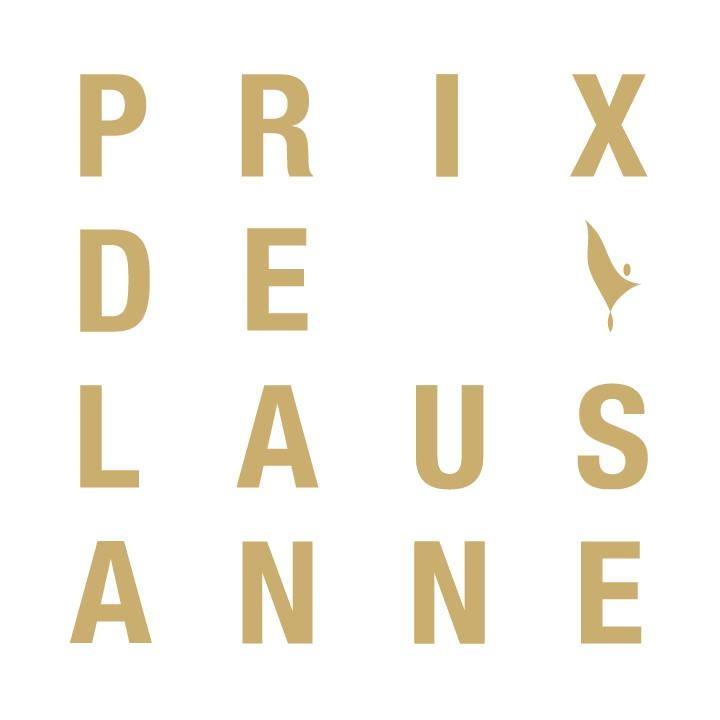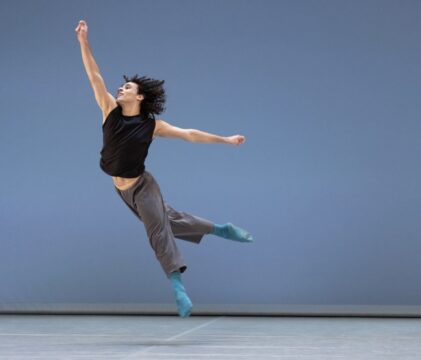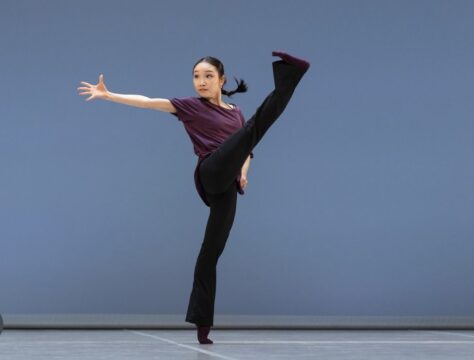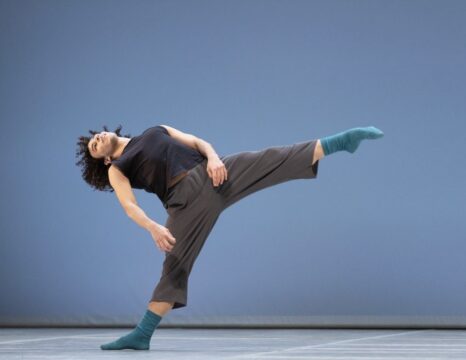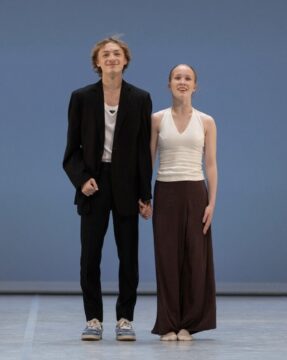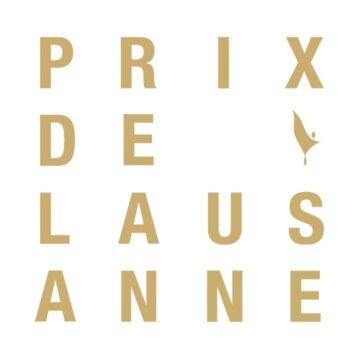Dans une remarquable démonstration d’innovation, le Prix de Lausanne a une fois de plus souligné son rôle de pionnier dans le monde de la danse avec l’introduction d’un concours sur mesure pour les chorégraphes émergents : Le Young Creation Award (YCA). Pour sa quatrième édition, le YCA a attiré la participation de 55 chorégraphes ambitieux – 31 femmes et 24 hommes – provenant de 19 écoles partenaires. Parmi toutes ces variations, cinq ont été choisies et les 2 chorégraphies gagnantes ont été présentées durant l’intermède de la finale du concours.
Celle-ci seront intégrées au répertoire des variations contemporaines du Prix de Lausanne 2025.
Mais en quoi consiste le YCA?
Le YCA est un phare pour la prochaine vague de talents chorégraphiques, offrant une scène inégalée aux jeunes visionnaires pour présenter leurs créations, ancrées dans l’héritage prestigieux du Prix de Lausanne.
Il célèbre la réussite artistique dans un cadre accueillant et compétitif, tout en nourrissant l’esprit inventif des jeunes danseurs, les encourageant à explorer l’art délicat et la technique de la chorégraphie.
Cette initiative se dresse comme une pierre angulaire de l’innovation et de l’excellence dans le monde de la danse, façonnant l’avenir de l’expression chorégraphique.
A la première place, Quinn Bates a surpris avec « Groovin’», une pièce où le danseur Miguel Artur Alves Oliveira avait toute la scène pour laisser libre court à ses mouvements, incarnant l’esprit d’un rappeur élégant avec ses chaussettes vertes. Une image détonante de la norme du ballet classique, réglé sur une ambiance de musique de rue aussi surprenante qu’innovante.

À la deuxième place, Kseniya Kosava a été récompensée pour « Under Glass », captivant le public à travers la performance gracieuse et éthérée de Sakura Natorigawa. Un moment poétique où la musique et la danse convergeaient pour suspendre le temps, mettant en avant la sensibilité de la danseuse dans une performance qui aura sans nul doute parlé à toutes les âmes introverties présentes dans la salle.
Bien que seulement deux aient été officiellement récompensés, un autre talent nous a tapé dans l’œil : Eden Dambrine, un jeune chorégraphe français, qui a également laissé une forte impression dans la salle du théâtre de Beaulieu. Sa variation nommée « Sophie » en hommage à sa danseuse et amie, Sophie Ketelslegers, a montré une précision, une connexion et un témoignage d’amitié fort entre le chorégraphe et l’interprète. Leur collaboration était un témoignage d’amitié qui a permis à la jeune femme de briller avec douceur et puissance à la fois.
Cette année, le YCA a non seulement révélé les talents innovants de jeunes chorégraphes mais a aussi consolidé l’engagement du Prix de Lausanne pour le progrès de la danse, établissant ainsi une nouvelle norme pour l’expression artistique en chorégraphie.
Une mention spéciale à Alejandro Figueredo Moreno et son danseur Ernesto Brallant Munoz Martin pour leur pièce captivante “Somnium”, ainsi qu’à Alexander Alvarez Silvestre et son danseur Leonidas Adarmes pour leur travail profond “Hollow”. Les deux variations se sont démarquées par leur beauté, incarnant l’essence de la créativité et de la passion que le concours célèbre. Bien qu’ils n’aient pas remporté de prix, leurs réalisations ne sont pas moins significatives.
Être sélectionné comme finaliste parmi un groupe initial de 55 personnes représente un exploit remarquable, les distinguant déjà comme des lauréats à part entière. Leur participation et leur sélection mettent en lumière l’extraordinaire talent et le potentiel de chacun, annonçant un parcours prometteur dans le monde de la danse.
Cécile Beaubié
4 février 2024
Young Creation Award at the Prix de Lausanne: Elevating the Next Generation of Choreographers
In a remarkable display of innovation, the Prix de Lausanne has once again underscored its role as a pioneer in the dance world with the introduction of a bespoke competition for emerging choreographers: The Young Creation Award (YCA).
For its fourth edition, the YCA attracted the participation of 55 ambitious choreographers – 31 women and 24 men – from 19 partner schools. Out of all these variations, five were selected, and the 2 winning choreographies were presented during the interlude of the competition’s finale. These will be integrated into the repertoire of contemporary variations for the Prix de Lausanne 2025.
But what exactly is the YCA?
The YCA serves as a beacon for the next wave of choreographic talent, offering an unparalleled stage for young visionaries to showcase their creations, rooted in the prestigious heritage of the Prix de Lausanne. It celebrates artistic achievement within a welcoming and competitive framework, whilst nurturing the inventive spirit of young dancers, encouraging them to explore the delicate art and technique of choreography. This initiative stands as a cornerstone of innovation and excellence in the dance world, shaping the future of choreographic expression.
In first place, Quinn Bates surprised the audience with “Groovin’”, a piece where dancer Miguel Artur Alves Oliveira had the entire stage to unleash his movements, embodying the spirit of an elegant rapper – with his funny green socks. A striking image against the norm of classical ballet, set to a backdrop of street music as surprising as it is innovative.
In second place, Kseniya Kosava was rewarded for “Under Glass”, captivating the audience with the graceful and ethereal performance of dancer Sakura Natorigawa. A poetic moment where music and dance converged to suspend time, showcasing the dancer’s sensitivity in a performance that undoubtedly spoke to every introverted soul in the audience.
Although only two were officially awarded, another talent caught our eye: Eden Dambrine, a young French choreographer, who also left a strong impression in the Beaulieu Theatre hall.
His variation named “Sophie”, in homage to his dancer and friend, Sophie Ketelslegers, demonstrated precision, a connection, and a strong testimony of friendship between the choreographer and the performer. Their collaboration was a testament to friendship that allowed the young woman to shine with both grace and strength.
This year, the YCA not only unveiled the innovative talents of young choreographers but also solidified the Prix de Lausanne’s commitment to the advancement of dance, thus establishing a new standard for artistic expression in choreography.
A special mention goes to Alejandro Figueredo Moreno and his dancer Ernesto Brallant Munoz Martin for their captivating piece “Somnium”, as well as to Alexander Alvarez Silvestre and his dancer Leonidas Adarmes for their profound work “Hollow”. Both variations stood out for their beauty, embodying the essence of creativity and passion that the competition celebrates. Although they did not win any prizes, their achievements are no less significant.
Being selected as a finalist from an initial group of 55 individuals represents a remarkable feat, distinguishing them as winners in their own right.
Their participation and selection highlight the extraordinary talent and potential of each, heralding a promising journey in the dance world.
Cécile Beaubié
04.02.2024
